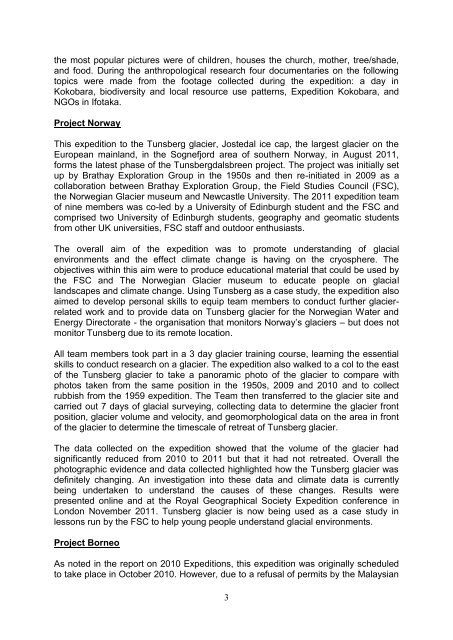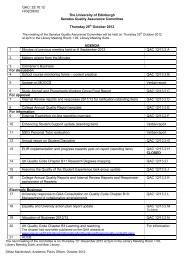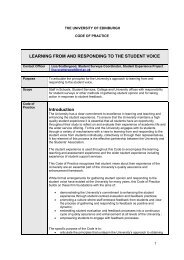Chapter 3 â Policy Implications for Gaelic - University of Edinburgh
Chapter 3 â Policy Implications for Gaelic - University of Edinburgh
Chapter 3 â Policy Implications for Gaelic - University of Edinburgh
You also want an ePaper? Increase the reach of your titles
YUMPU automatically turns print PDFs into web optimized ePapers that Google loves.
the most popular pictures were <strong>of</strong> children, houses the church, mother, tree/shade,<br />
and food. During the anthropological research four documentaries on the following<br />
topics were made from the footage collected during the expedition: a day in<br />
Kokobara, biodiversity and local resource use patterns, Expedition Kokobara, and<br />
NGOs in Ifotaka.<br />
Project Norway<br />
This expedition to the Tunsberg glacier, Jostedal ice cap, the largest glacier on the<br />
European mainland, in the Sognefjord area <strong>of</strong> southern Norway, in August 2011,<br />
<strong>for</strong>ms the latest phase <strong>of</strong> the Tunsbergdalsbreen project. The project was initially set<br />
up by Brathay Exploration Group in the 1950s and then re-initiated in 2009 as a<br />
collaboration between Brathay Exploration Group, the Field Studies Council (FSC),<br />
the Norwegian Glacier museum and Newcastle <strong>University</strong>. The 2011 expedition team<br />
<strong>of</strong> nine members was co-led by a <strong>University</strong> <strong>of</strong> <strong>Edinburgh</strong> student and the FSC and<br />
comprised two <strong>University</strong> <strong>of</strong> <strong>Edinburgh</strong> students, geography and geomatic students<br />
from other UK universities, FSC staff and outdoor enthusiasts.<br />
The overall aim <strong>of</strong> the expedition was to promote understanding <strong>of</strong> glacial<br />
environments and the effect climate change is having on the cryosphere. The<br />
objectives within this aim were to produce educational material that could be used by<br />
the FSC and The Norwegian Glacier museum to educate people on glacial<br />
landscapes and climate change. Using Tunsberg as a case study, the expedition also<br />
aimed to develop personal skills to equip team members to conduct further glacierrelated<br />
work and to provide data on Tunsberg glacier <strong>for</strong> the Norwegian Water and<br />
Energy Directorate - the organisation that monitors Norway’s glaciers – but does not<br />
monitor Tunsberg due to its remote location.<br />
All team members took part in a 3 day glacier training course, learning the essential<br />
skills to conduct research on a glacier. The expedition also walked to a col to the east<br />
<strong>of</strong> the Tunsberg glacier to take a panoramic photo <strong>of</strong> the glacier to compare with<br />
photos taken from the same position in the 1950s, 2009 and 2010 and to collect<br />
rubbish from the 1959 expedition. The Team then transferred to the glacier site and<br />
carried out 7 days <strong>of</strong> glacial surveying, collecting data to determine the glacier front<br />
position, glacier volume and velocity, and geomorphological data on the area in front<br />
<strong>of</strong> the glacier to determine the timescale <strong>of</strong> retreat <strong>of</strong> Tunsberg glacier.<br />
The data collected on the expedition showed that the volume <strong>of</strong> the glacier had<br />
significantly reduced from 2010 to 2011 but that it had not retreated. Overall the<br />
photographic evidence and data collected highlighted how the Tunsberg glacier was<br />
definitely changing. An investigation into these data and climate data is currently<br />
being undertaken to understand the causes <strong>of</strong> these changes. Results were<br />
presented online and at the Royal Geographical Society Expedition conference in<br />
London November 2011. Tunsberg glacier is now being used as a case study in<br />
lessons run by the FSC to help young people understand glacial environments.<br />
Project Borneo<br />
As noted in the report on 2010 Expeditions, this expedition was originally scheduled<br />
to take place in October 2010. However, due to a refusal <strong>of</strong> permits by the Malaysian<br />
3






